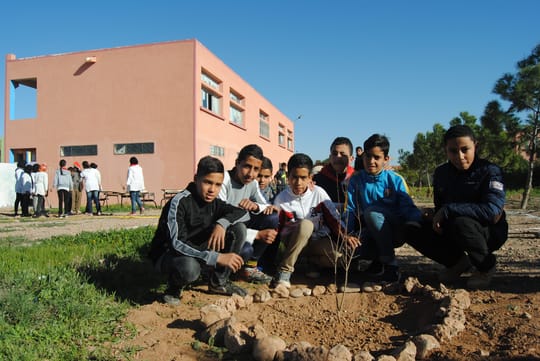On day two of our visit to Tiznit, the first stop was a school in a rural community that desired funding to improve its water infrastructure. The school has been working on improving the conditions of the school, with having new buildings and creating an agricultural presence on its school grounds. During the visit, I was able to witness a proposition that HAF has to consider whether it meets the conditions to receive funding.
We learned that with the partnership with HAF, the school had planted trees and is currently tending to them. The existing water infrastructure at the school is a well. However, the well is not operated through a solar panel water pump, so money is needed to be invested into the well after it is in place. There is a local spring, which the school has access to every ten days. They have traditional Amazigh water infrastructure in place that allows them to direct the water to the plants. Since there is no infrastructure in place for them to store the water they utilize flood irrigation to water the plants. The school was asking for HAF to invest in their school’s agriculture and water infrastructure, which would be a plan that would total around 30,000 USD. This puts HAF into a position in which it should allocate money for the school to improve its water infrastructure.
During the tour around the school, we were informed about the current conditions of the water infrastructure and the desires the school admin had for the future of the program. During the presentation, I was wondering where the profits from the fruit product are placed. Whether all of the funding is reinvested into the school, where it can be directed to the school. Which could potentially allow the school to stop having to charge the students for their transportation to school. Despite the profits only being directed to the school, schools are a key aspect of communities and development. Schools possessing monetary streams aid communities as a whole. Education allows for young community members to increase their skill set, which opens up opportunities for them and the community as a whole. This made me believe that it would be a nice allocation of resources for HAF.
Visiting this school illustrated to me the difficult choices that HAF has to make when they are deciding where to place funding and the numerous conditions they have to consider. An important aspect that was pointed out that had to be determined for a decision for funding to be made was whether the members of the community wanted the investment in agriculture, or if it was solely the school’s administration who wanted the new water infrastructure.
The children can not be responsible for tending to the trees, so this requires community members to participate in the care of the trees. If the members of the community do not have an interest or an incentive to maintain the trees, then HAF providing water infrastructure to be able to care for more trees would be an illogical allocation of their resources. Also knowing whether the community would be interested in the improvement of the water infrastructure at the school would have to be taken into account when making the decision. The community is not only needed because they would be a necessary aspect for maintaining the trees, but also the community is also a part of the rotation for access to the spring water. If the school creates the infrastructure to store spring water, they will utilize more of the spring water during the days they have access to it. This could lead to the spring water supply decreasing, as more of the water is removed from the supply. These factors are necessary to consider when deciding whether HAF should invest in improving the water infrastructure of the school. This illustrates the difficult decisions that are necessary for development foundations to make. It would be difficult for me to deny people access to a constant supply of water, but when resources are scarce foundations must make difficult decisions that would lead to the most benefit.
